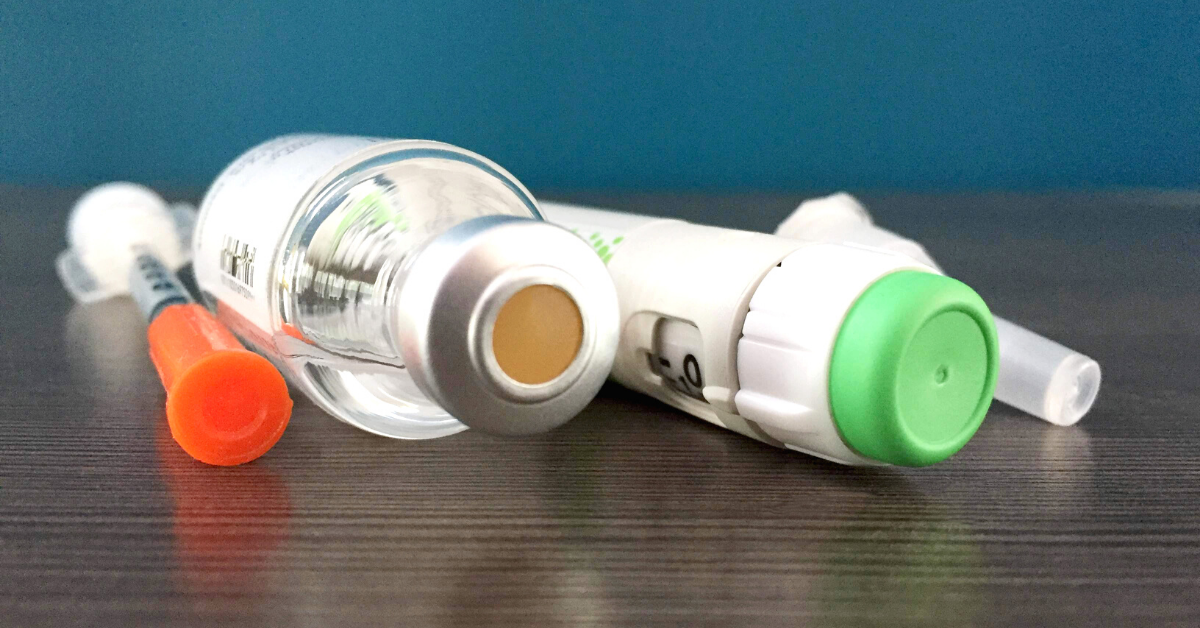
Here's a breakdown of insulin options available today, how they work and how to choose the best ones for you.
Every living mammal needs insulin to stay alive. For those of us with diabetes, we are forever grateful to Frederick Banting and Charles Best for discovering a way to extract insulin from the islet cells of pigs and cows back in 1921.
To them, we owe our lives!
Fortunately, today we have synthetic insulin and no longer need to extract it from pigs and cows! Even better, we have a slurry of synthetic insulin options to choose from based on our lifestyle, our body’s needs, our age, and how our body responds to one insulin versus another.
The finer details that differentiate these insulins from one another is one thing that makes life with diabetes a little easier.
What is insulin?
Insulin is considered the most powerful hormone in the human body. Without it, no human being could stay alive.
It’s secreted from the beta-cells produced by your pancreas. In a non-diabetic, the cells in your pancreas know exactly when and how much insulin to secrete in order to use the glucose in your bloodstream for fuel. Insulin carries that glucose to every area of your body and ensures that your blood sugar levels stay within the ideal healthy range.
In people with type 1 diabetes, your immune system is attacking those beta-cells and destroying their ability to secrete insulin.
In people with type 2 diabetes, either your body is struggling to produce enough insulin due to gradual beta-cell dysfunction or its struggling to effectively make use of the insulin you do produce due to severe insulin resistance.
Let’s take a look at today’s insulin options. [1]
Rapid-acting insulin: for meals & corrections
Rapid-acting insulin is an essential part of blood sugar management for anyone with type 1 diabetes, and for some people with type 2 diabetes.
It begins working in your bloodstream within 15 minutes -- and the newest type of rapid-acting insulin, Fiasp [2], is absorbed a little bit sooner because of the addition of niacinamide and an amino acid to the same aspart molecule as Novolog. While it enters the blood stream quicker, its effect onset is about the same as Novolog.
Rapid-acting insulin is taken either via injection with a syringe or insulin pen, or with an insulin pump or pod. When taken via injection, it’s used to cover your insulin needs when you eat and to correct high blood sugar levels. When taken via pump or pod, rapid-acting insulin also covers your “background” insulin needs in addition to meals and corrections. In a pump or pod, rapid-acting insulin is programmed to drip, drip, drip a small amount every hour.
The last option on this list is inhaled insulin [3] which is a meal-time insulin intended for those with type 1 or type 2 diabetes as an alternative to traditional liquid insulin. It starts working faster, peaks sooner, and has a shorter duration than liquid insulin so it doesn't keep driving blood sugar down.
| Brand Name | Generic Name | Manufacturer | Effect Onset | Peak | Duration |
|---|---|---|---|---|---|
| Novolog | Insulin aspart | Novo Nordisk | 15 min | 1 hr | 2 to 4 hrs |
| Humalog / Admelog | Insulin lispro | Lilly | 15 min | 1 hr | 2 to 4 hrs |
| Admelog | Insulin lispro | Sanofi | 15 min | 1 hr | 2 to 4 hrs |
| Apidra | Insulin glulisine | Sanofi | 15 min | 1.5 hr | 2 to 4 hrs |
| Fiasp | Insulin aspart | Novo Nordisk | 15 min | 1.5 hr | 5 to 7 hrs |
| Afrezza | Inhaled insulin | MannKind | 12 min | 35 to 45 min | 1.5 to 3 hrs |
Long-acting basal insulin
Long-acting insulin is used to cover the background insulin needs in people with type 1 and type 2 diabetes.
Much like your pancreas (or an insulin pump) provides a constant drip, drip, drip of insulin, long-acting insulin is injected once or twice a day and gradually works in your bloodstream over the course of about 24 hours.
The newest long-acting insulin -- Tresiba -- is designed to stay in your system for up to 42 hours but it is still intended to be taken daily.
| Brand Name | Generic Name | Manufacturer | Half-Life | Peak | Duration |
|---|---|---|---|---|---|
| Basaglar | Insulin glargine (U-100) | Lilly | 12 hrs | Minimal | 24 hrs |
| Lantus | Insulin glargine (U-100) | Sanofi | 12 hrs | Minimal | 24 hrs |
| Toujeo | Insulin glargine (U-300) | Sanofi | 19 hrs | No significant peak | 36 hrs |
| Tresiba | Insulin degludec | Novo Nordisk | 25 hrs | No significant peak | 42 hrs |
| Levemir | Insulin detemir | Novo Nordisk | 5 to 7 hrs | Minimal | 24 hrs |
Older insulins
We’re lucky to have the previously mentioned insulin options (and newer technology like pumps and pods) because they provide us with tremendous flexibility in when and how much we eat.
Before these modern insulin options, people with diabetes who need insulin had essentially no choice in which insulin they took. Short-acting (regular) and intermediate-acting (NPH) insulin were our only options.
Today, you can get these two older types of insulin for $30/vial from Walmart without a prescription -- but don’t jump in your car quite yet.
These older insulins may be very affordable compared to newer insulins, but there’s a reason for this: when used on their own, they do not provide the same flexibility and overall blood sugar management.
Research has shown that compared to older insulins (regular and NPH), people with diabetes taking newer insulins are:
For example, the way older insulins stay active in your system requires a very regimented life: what you eat, when you eat, how much you eat. Your insulin dose demands that you eat the same amount of carbohydrates at the same time of day every single day. If you eat too much or you eat too little, you’ll inevitably face high and low blood sugars.
Let’s take a closer look at regular and NPH insulin.
Short-acting insulin
Short-acting insulin is taken to cover your mealtime insulin needs but it takes much longer to become active in your system. It stays in your body for nearly twice the length of time compared to rapid-acting insulin which means your risk of low blood sugars around physical activity and missing a meal is much higher.
| Brand Name | Generic Name | Manufacturer | Effect Onset | Peak | Duration |
|---|---|---|---|---|---|
| Humulin R | Regular | Lilly | 30 to 60 min | 2 to 4 hrs | 6 to 8 hrs |
| Novolin R | Regular | Novo Nordisk | 30 to 60 min | 2 to 4 hrs | 6 to 8 hrs |
Intermediate-acting insulin
This option was the only background insulin option prior to the invention of long-acting insulin and insulin pumps (which really only became widely available in the very late 90s to early 2000s).
Unlike today’s better background insulin options, NPH insulin has a larger peak and trails off in a much shorter time. NPH stays active in your body for about 14 hours, must be taken twice per day because of its weakened effect at that point, and begins to peaks significantly after about 4 hours which means you must eat a small snack to prevent a low blood sugar at that time of day.
| Brand Name | Generic Name | Manufacturer | Effect Onset | Peak | Duration |
|---|---|---|---|---|---|
| Humulin N | NPH | Lilly | 1 to 3 hrs | 6 to 10 hrs | 14 to 24 hrs |
| Novolin N | NPH | Novo Nordisk | 1 to 3 hrs | 6 to 10 hrs | 14 to 24 hrs |
Which is the best insulin option for you?
Determining the right insulin option(s) for you really comes down to weighing the pros and cons of each option.
For example, I personally hate the feeling of an insulin pump’s infusion site sitting in my skin. For me, it’s constantly itchy and painful because of my sensitive skin. This means I’m grateful for the option of long-acting insulin like Lantus, but that also means I’m taking many, many injections per day to keep my blood sugars in a healthy range.
Someone else, on the other hand, might hate taking so many injections and would easily choose wearing an insulin pump over multiple daily injections (MDI).
Delivery method preferences can impact your choice. Here are details around insulin delivery methods to think about.
Multiple daily injections (MDI) with modern insulins
- rapid-acting insulin for meals and correcting high blood sugar (bolus)
- long-acting insulin is required daily to meet your background (basal) insulin needs
- offers a more flexible lifestyle
- delivery options: vial and syringes, or insulin pens and pen needles
MDI with older insulins
- short-acting insulin for meals (bolus)
- intermediate-acting insulin needed for basal (usually morning and night)
- stringent lifestyle required for optimal results and safety
- vial and syringes delivery option only
Insulin pump
- only one insulin needed for both bolus and basal
- offers a more flexible lifestyle
- allows for "micro-dosing" very small amounts of insulin
- no long-acting insulin needed
- not all rapid-acting insulins are approved to be used in a pump
- long-acting, short-acting, and intermediate-acting insulins cannot be used in a pump
- much higher cost than MDI (may be reduced with insurance coverage)
Using inhaled insulin
- no needles for bolus dosing
- dosing options limited to 4, 8 or 12 unit cartridges (unit conversion is different from liquid insulin)
- injections of long-acting insulin still required for background (basal) insulin needs
None of our options are perfect. They all come with flaws. And no matter which options you choose, you have to put in a great deal of effort to manage your diabetes every single day.
Insulin doesn’t make living with diabetes easy. It simply makes living with diabetes possible.
Work with your healthcare team to determine the best choices for you.
Insulin is expensive. Check out the Diathrive Guide to Insulin Savings to find out how you can reduce your financial burden.
References:
[1] Current insulin options: https://learnem.org/insulin-comparison-chart/
[2] Fiasp onset: https://www.fiasppro.com/the-fiasp-story/onset-of-appearance.html
[3] Afrezza profile: https://www.afrezza.com

